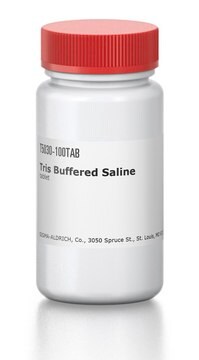480012
NDSB Set
Contains the following non-detergent sulfobetaines: 5 g of NDSB-195, 25 g of NDSB-201, and 5 g of NDSB-256.
Autenticatiper visualizzare i prezzi riservati alla tua organizzazione & contrattuali
About This Item
Codice UNSPSC:
12352200
NACRES:
NA.21
Prodotti consigliati
Livello qualitativo
Forma fisica
solid
Produttore/marchio commerciale
Calbiochem®
Condizioni di stoccaggio
OK to freeze
desiccated (hygroscopic)
Solubilità
water: 50 mg/mL
Condizioni di spedizione
ambient
Temperatura di conservazione
15-25°C
Descrizione generale
Contains the following non-detergent sulfobetaines: 5 g of NDSB-195 (Cat. No. 480001), 25 g of NDSB-201 (Cat. No. 480005), and 5 g of NDSB-256 (Cat. No. 480010). Supplied with a data sheet.
Non-detergent sulfobetaines (NDSBs) are zwitterionic compounds. Like zwittergents (zwitterionic detergents), NDSBs carry the sulfobetaine hydrophilic head group. However, unlike zwittergents, the hydrophobic group in NDSBs is too short for micellar formation even at concentrations as high as 1M. Hence, NDSBs do not behave like detergents. Because of their zwitterionic nature, NDSBs were first employed to neutralize electrostatic interactions without increasing the conductivity in native isoelectrofocusing gels. Recently they have found utility in various other applications including isolation of membrane proteins, purification of nuclear proteins and halophilic proteins, renaturation of chemically and thermally denatured proteins and protein crystallization. They are potentially useful in solubilization and renaturation of fusion proteins from inclusion bodies. It is hypothesized that the hydrophobic group, although short, interacts with the hydrophobic regions of the protein preventing aggregation during renaturation. Also, presumably, the contribution from the short hydrophobic groups combined with charge neutralization ability of the sulfobetaine group results in higher yields of membrane proteins.
NDSBs do not interfere with enzymatic assays based on chromogenic substrates bearing nitrophenyl groups and do not inhibit the activities of β-galactosidase and alkaline phosphatase, the two enzymes tested thus far. NDSB-195 has the added advantage in that it does not absorb at 280 nm, making it compatible with protein purification procedures in which the protein concentrations are determined by absorbance measurements at 280 nm. Supplied with a data sheet.
NDSBs do not interfere with enzymatic assays based on chromogenic substrates bearing nitrophenyl groups and do not inhibit the activities of β-galactosidase and alkaline phosphatase, the two enzymes tested thus far. NDSB-195 has the added advantage in that it does not absorb at 280 nm, making it compatible with protein purification procedures in which the protein concentrations are determined by absorbance measurements at 280 nm. Supplied with a data sheet.
Attenzione
Toxicity: Irritant (B)
Ricostituzione
Store lyophilized products at room temperature. Following reconstitution, store in the refrigerator (4°C) or at room temperature (20°C).
Altre note
Goldberg, M.E., et al. 1996. Folding and Design1, 21.
Goldberg, M.E., et al. 1995. Folding & Design1, 21.
Vuillard, L., et al. 1995. Biochem. J.305, 337.
Vuillard, L., et al. 1995. Anal. Biochem.230, 290.
Vuillard, L., et al. 1994. FEBS Lett.353, 294.
Goldberg, M.E., et al. 1995. Folding & Design1, 21.
Vuillard, L., et al. 1995. Biochem. J.305, 337.
Vuillard, L., et al. 1995. Anal. Biochem.230, 290.
Vuillard, L., et al. 1994. FEBS Lett.353, 294.
Note legali
CALBIOCHEM is a registered trademark of Merck KGaA, Darmstadt, Germany
Codice della classe di stoccaggio
11 - Combustible Solids
Certificati d'analisi (COA)
Cerca il Certificati d'analisi (COA) digitando il numero di lotto/batch corrispondente. I numeri di lotto o di batch sono stampati sull'etichetta dei prodotti dopo la parola ‘Lotto’ o ‘Batch’.
Possiedi già questo prodotto?
I documenti relativi ai prodotti acquistati recentemente sono disponibili nell’Archivio dei documenti.
Il team dei nostri ricercatori vanta grande esperienza in tutte le aree della ricerca quali Life Science, scienza dei materiali, sintesi chimica, cromatografia, discipline analitiche, ecc..
Contatta l'Assistenza Tecnica.







